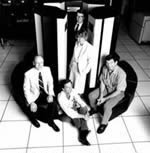"Towards DNA Sequencing Chips"
Dr. Pavel Pevzner
Professor, Department of Mathematics
University of Southern California
Since 1987, OSC has been providing our clients services in four areas, or functions:
Supercomputing. OSC provides the computational power and storage that scientists need to meet their research goals. Whether researchers need to harness the incredible power of a parallel processor cluster to better understand deep space, a vector processor machine to do weather modeling, or a mid-size shared memory processor system to model the human heart, OSC has the hardware and software solutions to meet their needs.
Research. A staff of high performance computing and networking research experts maintain active research programs in HPC and Networking, Homeland Security and Defense, Environmental Sciences, Engineering and Life Sciences. Our goals are to lead science and engineering research efforts, assist researchers with custom needs and collaborate with regional, national and international researchers in groundbreaking initiatives.
Education. OSC has a national reputation for its training and education programs. Staff teach faculty and student researchers through scientific computing workshops, one-on-one classes, and web-based portal training. Ohio students gain exposure to the world of high performance computing and networking during our annual summer institutes for young women in middle school and for junior and senior high school students. And, the statewide, virtual Ralph Regula School of Computational Science coordinates computational science and engineering education activities for all levels of learning.
Cyberinfrastructure. The Ohio Supercomputer Center’s cyberinfrastructure and software development researchers provide the user community with various high performance computing software options. This variety enables researchers to select parallel computing languages they most prefer, and just as important, it creates a test bed for exploring these systems. By taking a holistic approach to generating efficient supercomputing applications for researchers, the Center’s cyberinfrastructure and software development research capitalizes on all the components within the cycle of innovation — development, experimentation, and analysis - and continuously improves the services provided.
Dr. Pavel Pevzner
Professor, Department of Mathematics
University of Southern California
 Empower. Partner. Lead. These are the philosophies and actions that define the Ohio Supercomputer Center’s two decades of innovation and service. And, as 2007 marks the Center’s 20th anniversary, the mission to empower, partner and lead state and national partners will guide the Center as it forges ahead as a center of excellence.
Empower. Partner. Lead. These are the philosophies and actions that define the Ohio Supercomputer Center’s two decades of innovation and service. And, as 2007 marks the Center’s 20th anniversary, the mission to empower, partner and lead state and national partners will guide the Center as it forges ahead as a center of excellence.
State officials converged at Stark State College of Technology today to focus on the Third Frontier Network's (TFN) capacities to support fuel cell research. The Third Frontier Network will make Ohio a world leader in using technologically advanced networking to improve education, research and medical care.
Columbus, Ohio (Sept. 15, 2011) – Ohio's statewide higher education technology consortia have been reorganized today under an umbrella organization known as the Ohio Technology Consortium (OH-TECH), according to an Ohio Board of Regents (BOR) directive.
The Ohio Supercomputer Center (OSC) and The Ohio State University College of Veterinary Medicine (OSU) are designing a groundbreaking virtual surgical training program using software and hardware developed at OSC. The study, officially called “Simulation Technology in Veterinary Education: Research and Surgical Training,” began in January 2007 and will last for about eight months.
More than 1000 people from over 200 institutions in 27 countries on five continents dialed into the 5th Annual Megaconference on December 10th 2003, to participate in the world's largest simultaneous Internet videoconferencing event to test, discuss, and present applications of IP-based H.323 Videoconferencing.
Click here to view the streaming video from this event. (You will need Windows Media Player.)
Jack Dongarra, internationally-known expert in high performance computing (HPC), recently spoke at a lecture series sponsored by the Ohio Supercomputer Center (OSC) on Jan. 11, 2007. In his speech, “Supercomputers & Clusters & Grids, Oh My!” Dongarra addressed current trends, rapid changes, and some of the biggest challenges facing the HPC world.
|
Approximately 60 professionals from academia, industry and the military attended the Fifth Annual Summer Institute for Advanced Computation (SIAC), sponsored by the Information Technology Research Institute and Ohio Supercomputer Center (OSC). This year’s SIAC, held at Wright State University on August 27-29, 2003, focused on Homeland Security Computing. |
Algorithm searches for models that best explain experimental data
Columbus, Ohio (Aug. 2, 2011) – A Franklin University professor recently developed an evolutionary computation approach that offers researchers the flexibility to search for models that can best explain experimental data derived from many types of applications, including economics.
Joining high performance computing (HPC) applications with small- and medium-sized companies is one step closer to reality as the Ohio Supercomputer Center (OSC) and the Edison Welding Institute (EWI) announced a partnership agreement today. As part of its innovative Blue Collar Computing initiative, OSC will provide remote portal access of HPC systems and software to EWI welding applications—a tremendous cost-saving resource that will reach engineers at over 200 companies.